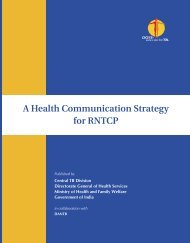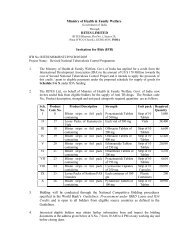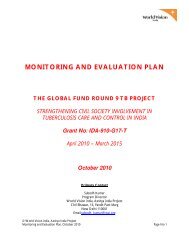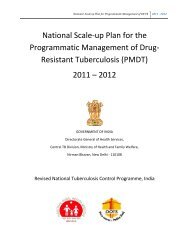RNTCP Annual Report 2012 - TBC India
RNTCP Annual Report 2012 - TBC India
RNTCP Annual Report 2012 - TBC India
Create successful ePaper yourself
Turn your PDF publications into a flip-book with our unique Google optimized e-Paper software.
2 categories (New and Previously treated cases) based<br />
on the recommendations of experts and endorsement<br />
by National Task Force for Medical colleges.<br />
Comprehensive training materials have been developed<br />
for all categories of staff. The training materials are<br />
modular in content and a number of them have been<br />
recently revised keeping in view the new developments<br />
in <strong>RNTCP</strong>. Modular trainings ensures uniform standard<br />
and avoids possible subjectivity and bias in trainings.<br />
To improve access to tribal and other marginalized<br />
groups the programme has developed a Tribal action<br />
plan which is being implemented with the provision of<br />
additional TB Units and DMCs in tribal/difficult areas,<br />
provision of TBHVs (peripheral health worker) for urban<br />
areas, compensation for transportation of patient &<br />
attendant in tribal areas, higher rate of salary to contractual<br />
staff posted in tribal areas and enhanced vehicle<br />
maintenance and travel allowance in tribal areas Studies<br />
to document utilization by marginalized groups<br />
Drug Resistance Surveillance (DRS) of Gujarat,<br />
Maharashtra and Andhra Pradesh, estimated the<br />
prevalence of Multidrug Resistant TB (MDR-TB) to be<br />
about 2-3% in new cases and 12-17% in retreatment cases.<br />
These surveys also indicate that the prevalence of MDR-<br />
TB is not increasing in the country.<br />
The programme is in the process of establishing a network<br />
of accredited Culture and Drug Susceptibility Testing<br />
(DST) Intermediate Reference Laboratories (IRLs) across<br />
the country in a phased manner for diagnosis and follow<br />
up of MDR TB patients. Currently 38 labs are accredited<br />
and are functioning across the country.<br />
The <strong>RNTCP</strong> has initiated evaluation of the Gene-Xpert<br />
TB-RIF in line with the global consultation guidelines to<br />
gather evidence for use within the country in various<br />
settings including non-risk settings.<br />
LAMP (Loop mediated isothermal amplification) is a<br />
manual NAAT that can be performed at microscopy<br />
level is currently undergoing validation by FIND in IGMS<br />
Wardha.<br />
Multi Drug resistant TB (MDR TB): MDR-TB<br />
services have been initiated in all states in the country. All<br />
35 States/UTs have introduced PMDT services in some<br />
districts with variable access and scaling up. 508 million<br />
(43%) population have access to services that varies from<br />
states to state as depicted in the figure below. 38287 MDR<br />
TB suspects have been examined till the end of 2011,<br />
10267 MDR-TB patients have been diagnosed and 6994<br />
have been put on treatment.<br />
Executive Summary<br />
TB/HIV: The "National framework of Joint TB/HIV<br />
Collaborative activities" was revised in 2009 which<br />
establishes uniform activities at ART centres and ICTCs<br />
nationwide for intensified TB case finding and reporting,<br />
and set the ground for better monitoring and evaluation<br />
jointly by the two programmes with a new monitoring<br />
framework and revised reporting formats and<br />
mechanisms.<br />
Intensified TB-HIV package has been introduced in the<br />
entire country in 2011.In 2011 with close to 7 lakh TB<br />
suspects identified and tested for TB in HIV care settings;<br />
of them, close to 84,000 TB cases were diagnosed and<br />
linked to TB treatment services. Among the 23 states<br />
reported in 2011, close to 6 lakh TB patients were<br />
ascertained for their HIV status (67% of TB patients<br />
registered) and about 44,000 HIV-infected TB patients<br />
were diagnosed.<br />
Public Private Mix (PPM): <strong>RNTCP</strong> has involved over<br />
1971 NGOs and 10,894 Private Practitioners. 150<br />
Corporate Hospitals and 297 Medical Collages are<br />
implementing <strong>RNTCP</strong>. The programme is having<br />
successful partnership with IMA, CBCI, PATH, The<br />
Union and World Vision <strong>India</strong>.<br />
Advocacy, communication & social mobilization<br />
(ACSM): An effective advocacy, communication & social<br />
mobilization (ACSM) strategy is in place. As envisaged<br />
under the Stop TB Strategy ACSM plays a major role, in<br />
order to maintain high visibility of TB and <strong>RNTCP</strong><br />
amongst policy makers, opinion leaders and<br />
community.Four regional level ACSM capacity building<br />
workshops were held by the program, wherein key<br />
functionaries in the field (STO, DTO, and implementing<br />
NGOs).National and Regional ACSM capacity building<br />
workshops were held in year 2011 to streamline the<br />
efforts.<br />
Operational research (OR): Second round of zonal<br />
ARTI surveys were completed in 2011 and 7 Prevalence<br />
Surveys were also completed and the results were<br />
discussed and shared in a series of workshops at national<br />
level in 2011. These results were used for the TB burden<br />
estimation and impact assessment. 72 thesis proposals<br />
and 14 OR proposals were approved by various Zonal<br />
OR committees in 2011.In addition seven OR studies<br />
were approved by National OR Committee of which 2<br />
have been completed and five are ongoing.<br />
Impact of the programme: TB mortality in the country<br />
has reduced from over 39 per hundred<br />
thousandpopulation in 1990 to 29 hundred thousand<br />
population in 2010 as per the WHO Global TB <strong>Report</strong><br />
2011. The prevalence of TB in the country has reduced<br />
3






